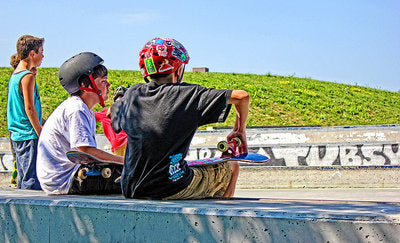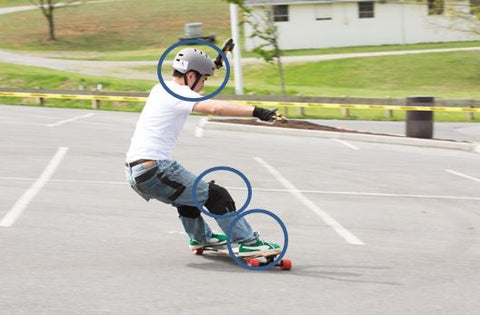3 Pieces of Essential Safety Gear to Avoid Road Rash

As with every sport, the proper equipment is essential for success. Skateboarding is a little different than most sports because you often ride over hard and unforgiving surfaces such as concrete or asphalt. As a longboarder myself, I’ve fallen plenty of times and have had quite a few cases of bad “road rash” (the scrapes you get when falling at fast speeds). As anybody can tell you, it’s not fun.
For people who are looking to learn, falling can discourage them from getting on their board again. Here are the necessary pieces of safety equipment that will help prevent injuries and keep you skating all day and night.
Always Necessary: Helmet
The helmet is the most essential piece of equipment that any skater, regardless of level, should always wear. I firmly believe that anytime you get on a skateboard you should wear a helmet. That might seem strict, but no matter how good of a skater you are, you just don’t know what will happen while skating. Somebody could suddenly step out in your path forcing you to bail out or hit them. Either way, you will be glad to be wearing a helmet.
Head injuries can also be some of the worst injuries and keep you from skateboarding for weeks or months. Just look at the professionals for guidance. Every single one in longboarding and skateboarding wears helmets when they ride because they care about their safety and want to continue skateboarding as long as possible.

(Helmets don’t have to be boring either. A lot of skaters (like the kid featured above) like to personalize their helmets with skate stickers. Photo credit to Don Gunn.)
When looking for the right helmet for you, I think it’s a personal choice between two of the best: The Triple 8 Longboard Helmet and the Protec Original Classic Helmet.
The one thing about the Triple 8 Helmet that I like is the terry cloth padding designed to absorb sweat. Besides keeping your face free from sweat, the padding is also replaceable allowing you to simply buy new padding and keep the shell.
In comparison, for ventilation, the Protec Original has 11 large vents that help circulate air within the helmet. This helmet is also certified against impacts by the Consumer Safety Product Commission.
Skate Shoes: Necessary if you want to stop
Foot braking is one of the best methods for beginners just learning how to stop on their board, and a lot of riders forget that a big part relies on your shoe choice for the day! Don’t be like me and ruin your new running shoes within a month because you were using them for skateboarding. Foot braking is rough on tread patterns and will destroy shoes that aren’t built for it.
The good thing about skateboarding shoes is that they are very easy to find. Ever heard of Vans? They are a classic and perfect skateboarding shoe. Every good skateboarding shoe has three things in common which primarily deal with the sole of the shoe: The sole is flat with a minimal tread pattern, is thick, and is made out of vulcanized rubber. Pick up a shoe with these characteristics and you’ll ensure a long life for your skateboarding shoes and a smooth stop.
Elbow/Knee Pads – Recommended for Tricks, Optional for Daily Riding
Elbow and knee pads are the last major protective equipment are common for skaters and longboarders. Some of the most common injuries in skateboarding are to the elbows and knees when you fall. However, while recommended, these pads are not strictly necessary for daily light riding.
(Above, a demonstration of all of the required safety gear (helmet, knee pads, and skate shoes) during a sliding session)
I mainly recommend pads when trying out new tricks or when starting to learn a new skill, such as sliding. When you attempt to learn new skills, you have to expect to fall a lot. Pads, like these, will prevent you from injuring yourself and allow you to push your limits when learning.
Lights: A Must at Night
If skating at night, the most important thing is to be seen. To that end, you have a variety of options from wearing a reflective vest, bright clothing, or even attaching lights to your body.
For night riding, you want at least two methods of illumination to ensure you are seen by cars and other people. Often, one simply isn’t enough for cars to notice you at night. A good combination for me is bright clothing and LED lights.
If you want something that will stick easily to your skateboard, you can use Board Blazers. In addition, always make sure to wear bright clothes or a reflective materia,l because although riding at night can be a lot of fun, it is also more dangerous than riding during the day.
Remember: Wear a helmet, elbow/knee pads, and use lights, and you’ll be ready to ride at night!
Author Bio: David runs the longboarding blog Review Longboards, which aims to provide high-quality information about the best longboards, safety gear, longboarding how-to’s available today. See his full guides on how to longboard and grabbing the best value longboard here.

